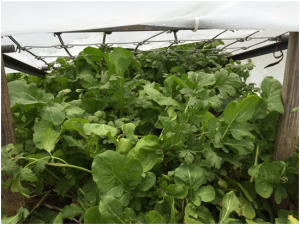By Stephanie Oaks
As fall gives way to winter, nighttime temperatures drop and the buzz of the chance of snow begins. Many of us have already experienced unusually cold temperatures this season, threatening to kill vegetation we hoped would have lasted at least until January. Even with the onset of winter, there is a way to make your fall vegetables last (a term called overwintering) by creating a warm micro climate for your plants. Here at No. 9 Farms we utilize three different overwintering systems—a greenhouse, hoop houses (also called high tunnels—although ours are not so tall!) and row covers.
Overwintering with Greenhouses
Our greenhouse is mainly used for herb and vegetable starts in the spring, but during the winter, it houses a raised bed with greens and onions that can withstand freezing temperatures. Our greenhouse feels like a sauna during the day on sunny days as the energy from the sun is captured and absorbed into heat conducting materials. This heat is given off during the night as the temperatures outside dip below freezing, keeping the temperature inside above freezing. Because we do not want to artificially heat our greenhouse during the winter months, the indoor temperatures will freeze after an overcast day, or when temperatures drop to the teens or single digits. The plants are still protected for overwintering, however, from biting winds, frost, ice, and snow. Before we had a greenhouse, we applied these same principles on a much smaller scale.
DIY Hoop Houses
Hoop houses can range anywhere from 3 feet high to 12 feet high. We have found that a hoop house that you can stand up in is much easier to work in! Our hoop houses are movable structures made from a wooden frame with straight sides. Our metal arches, or half hoops, are connected to the wooden frame at a height of about 2 1/2 feet by simply drilling perfectly sized holes into the frame. Brackets can also be used to secure the hoops to the outside of the frame. One-inch curved plastic or metal piping can be used for the hoop—we chose to invest in metal because of longevity.
Special clamps are used to attach the plastic sheeting to the arches (we purchase ours at johnnyseeds.com.) Our plastic sheeting is a 6 mil poly which is available at most hardware stores. The plastic sheeting at one end is attached to the frame while the plastic at the other end is left long and secured to the ground with a weight. This allows for easy access in and out, and ventilation on unusually warm days. If you are good at carpentry, a framed-in door can be built at one end of the hoop house. We carefully plan what grows in our hoop houses year-round, removing the plastic sheeting when the spring frosts have passed.
DIY Row Covers
The easiest of all of these projects is row covers. Our trellis frames that supported our summer vegetables are now covered in plastic sheeting with zip ties and secured to the ground with long sod staples. This allows you to quickly cover up those valuable rows of vegetables that are threatened by an early frost, or to cover intentionally planted winter vegetables that have already germinated. Most of our row covers are made from two-inch by four-inch hardware cloth, also known as welded wire or fence wire and is available at most hardware stores. The row covers are made with the same poly sheeting as our hoop houses, with the ends tied off and secured, but are allowed to ventilate on our warm Southern days.
With proper overwintering, you can enjoy lettuce, kale, bok choy, chard, radishes, carrots, leeks, green onions, cilantro, parsley, and all of your favorite cool-weather vegetables all through the winter—cover them up!
Stephanie Oaks lives in Ashland City, Tennessee, where she and her husband own and operate No. 9 Farms, an organic farm that specializes in berries, herbs, fruits and vegetables, and Christmas trees. Stephanie spends the remainder of her time homeschooling their two teenage children and teaching classes on organic gardening and healthy cooking.
Looking for more great tips on overwintering? Be sure to check out our in-depth article on how to extend growing season with cold frames and low tunnels!








